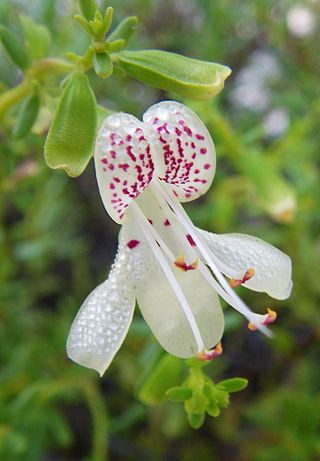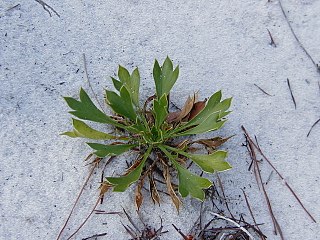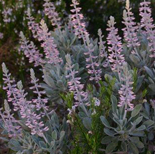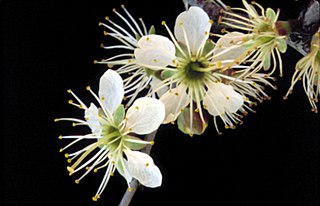
Buzz pollination or sonication is a technique used by some bees, such as solitary bees, to release pollen which is more or less firmly held by the anthers. The anthers of buzz-pollinated plant species are typically tubular, with an opening at only one end, and the pollen inside is smooth-grained and firmly attached. With self-fertile plants such as tomatoes, wind may be sufficient to shake loose the pollen through pores in the anther and accomplish pollination. Visits by bees may also shake loose some pollen, but more efficient pollination of those plants is accomplished by a few insect species who specialize in sonication or buzz pollination.

The Lake Wales Ridge National Wildlife Refuge is part of the United States National Wildlife Refuge (NWR) System, located in four separated areas on the Lake Wales Ridge east of US 27 between Davenport and Sebring Florida. The 1,194 acre (4.8 km2) refuge was established in 1990, to protect a host of plants and animals. It is also the first to be designated primarily for the preservation of endangered plants, and is not open to the general public. It contains a high proportion of remaining Florida scrub habitat. It is administered as part of the Merritt Island National Wildlife Refuge.

Warea carteri is a species of plant in the mustard family, Brassicaceae, known by the common names Carter's pinelandcress and Carter's mustard. It is an endangered, fire-dependent annual herb occurring in xeric, shrub-dominated habitats on the Lake Wales Ridge of central Florida in the United States.

Chionanthus pygmaeus is a rare species of flowering plant in the olive family known by the common name pygmy fringetree. It is endemic to Florida, where there are 46 known occurrences as of 2010. The plant is found in increasingly rare habitat in Central Florida that is being consumed for development, and some protected areas are not managed adequately. Most populations are small. It is a federally listed endangered species of the United States.

Clitoria fragrans is a rare species of flowering plant in the legume family known by the common name pigeon wings, or sweet-scented pigeon wings. It is endemic to Central Florida, where it was known most recently from 62 occurrences, but no current estimates of the total global population are available. The plant is a federally listed threatened species of the United States.

Conradina brevifolia is a rare species of shrub in the mint family known by the common name short-leaved false rosemary. It is endemic to Central Florida, where it is known only from the Lake Wales Ridge. There are perhaps 36 occurrences of the plant remaining, and 10 of these are likely to be destroyed as their habitat is fragmented in the coming years. About 15% of the Lake Wales Ridge, the only home territory of the plant, remains today, the rest having been cleared for development and citrus groves. Few of the extant populations have more than 25 plants. This is a federally listed endangered species of the United States.
Dicerandra cornutissima is a rare species of flowering plant in the mint family known by the common names longspurred mint, longspurred balm, and Robin's mint. It is endemic to Florida in the United States. It is found in Marion County, and possibly Sumter County, but it may have been totally extirpated from the latter. There are 12 known occurrences remaining as of 2017, down from 15 in 2000. The plant was federally listed as an endangered species in 1985.

Dicerandra frutescens is a rare species of flowering plant in the mint family known by the common names scrub mint and scrub balm. It is endemic to Highlands County, Florida, where it is known only from the Lake Wales Ridge. Its habitat is quickly being lost as it is converted to residential and agricultural use. It was federally listed as an endangered species of the United States in 1985.

Dicerandra immaculata is a rare species of flowering plant in the mint family known by the common names Lakela's mint, Olga's mint, and spotless balm. It is endemic to Florida in the United States, where it is known only from Indian River and St. Lucie counties. There are seven occurrences of the plant, two of which are scheduled for destruction as the land is cleared for development. The plant was federally listed as an endangered species in 1985.

Dicerandra is a genus of flowering plants in the mint family. Dicerandra comprises 11 species: six perennial and five annual species. The perennials have narrow ranges in Central Florida with small population sizes and only occur on ancient dune ridges along the Lake Wales Ridge or the Atlantic Coastal Ridge; the annual species occur more broadly on sandhill habitats to the north. The perennials’ habitat has been severely fragmented due to human development over the past century. As a result, all perennial species except one are listed as federally endangered. Annual species of the clade have large ranges when compared to perennial members, with distributions of annuals ranging for hundreds of miles from the Panhandle of Florida to southeastern Georgia, with the exception of Dicerandra radfordiana which is endemic to two sites along the Altamaha river. The genus is characterized by hornlike spurs on their anthers.

Echinocereus chisoensis is a rare North American species of cactus known by the common name Chisos Mountain hedgehog cactus, native to the Chihuahuan Desert of northern Mexico and the south-central United States.

Eryngium cuneifolium is a rare species of flowering plant in the carrot family known by the common names wedgeleaf eryngo, wedge-leaved button-snakeroot, and simply snakeroot. It is endemic to the state of Florida in the United States where it is known only from Highlands County. It is one of many rare species that can be found only on the Lake Wales Ridge, an area of high endemism. It was federally listed as an endangered species of the United States in 1987.

Hypericum cumulicola is a rare species of flowering plant in the family Hypericaceae known by the common name highlands scrub hypericum, or highlands scrub St. John's wort. It is endemic to Florida, where it is threatened by habitat loss and degradation. It is a federally listed endangered species of the United States.

Lupinus aridorum is a rare species of lupine known by the common name scrub lupine. It is endemic to Florida in the United States, where there were 10 known populations remaining in 2003. Fewer than 6000 individual plants were counted. It is threatened by the loss and degradation of its habitat. The scrub lupine is a federally listed endangered species of the United States.

Prunus geniculata is a rare species of plum known by the common name scrub plum. The species is endemic to Florida.
The Florida peninsula inland scrub is a shrubland community found on the Florida peninsula. The largest remaining blocks of inland scrub are in and around the Ocala National Forest and in the Lake Wales Ridge National Wildlife Refuge. The Archbold Biological Station near Lake Placid contains about 20 km2 (7.7 sq mi) of scrub habitat and sponsors biological research on it. The scrub occurs on a series of north-south running ridges composed of sand derived from ancient dune fields. The soil, a type of entisol, is derived from quartz and is low in organic matter, silt, and clay. Because the low-nutrient sandy soils do not retain moisture, the ecosystem is effectively an arid one.
Dicerandra modesta is a species of Dicerandra endemic to the Lake Wales Ridge in Central Florida. It is commonly known as blushing scrub balm. It is a listed state and federal endangered species. It is known only from a few populations in Polk County, Florida. It grows in scrub and sand hills.

Osmia calaminthae, commonly known as the blue calamintha bee, is a rare species of mason bee known only from two small areas in Florida, United States. It is considered Critically Imperiled by NatureServe. The common name for the bee is derived from its distinctly blue color and its favored host plant, Calamintha ashei.

Acanthomintha ilicifolia, known by the common name San Diego thornmint, is a rare species of flowering plant in the mint family. It is native to Baja California and San Diego County, California, where it is a resident of the chaparral and coastal sage scrub plant communities and vernal pools.


















